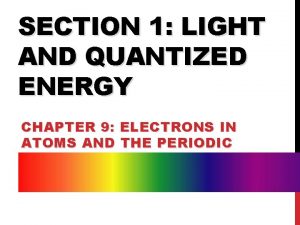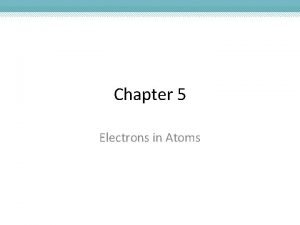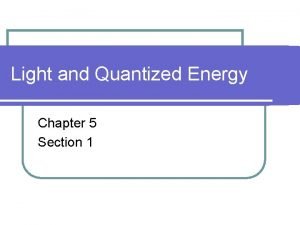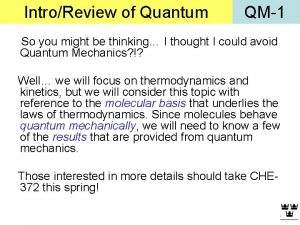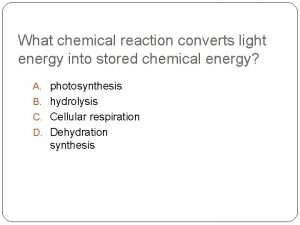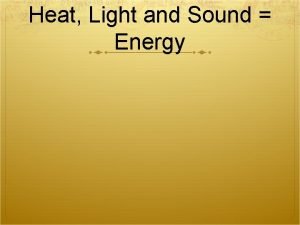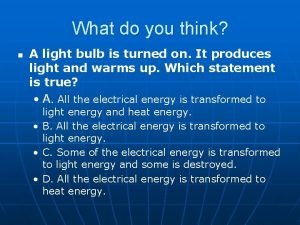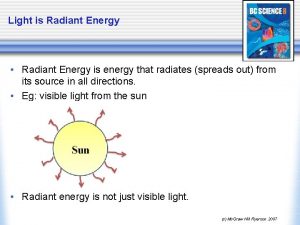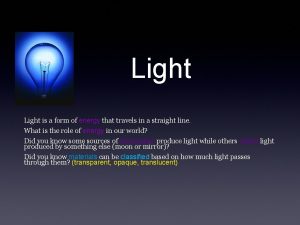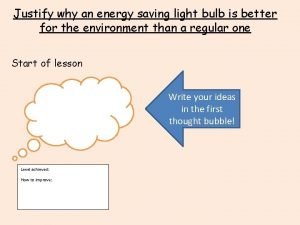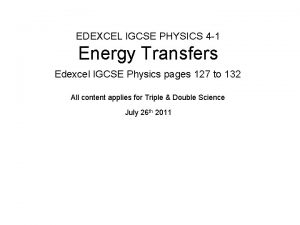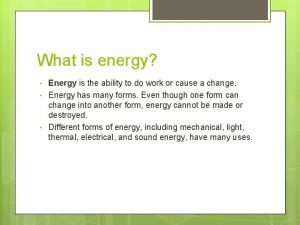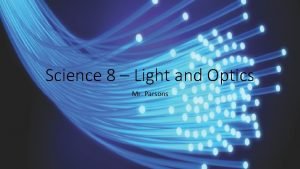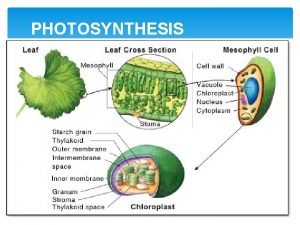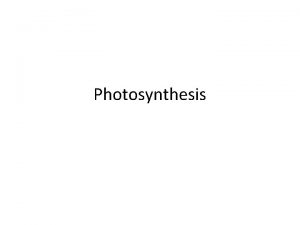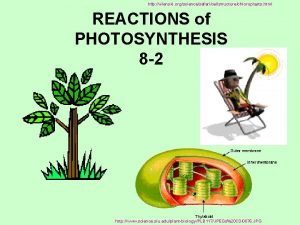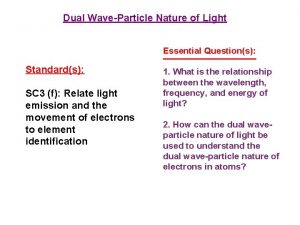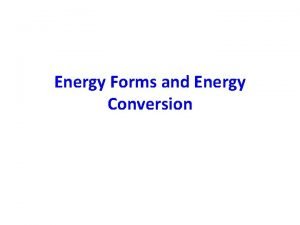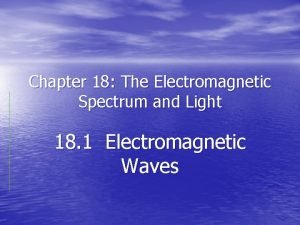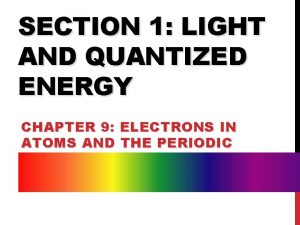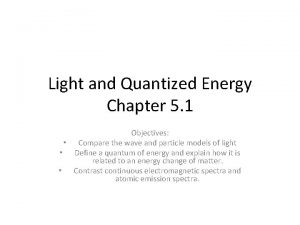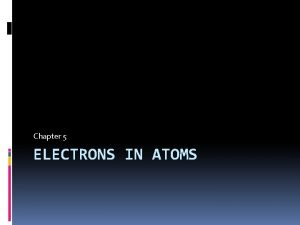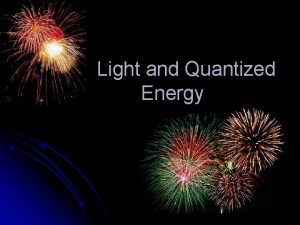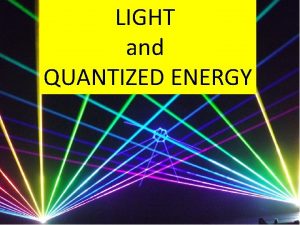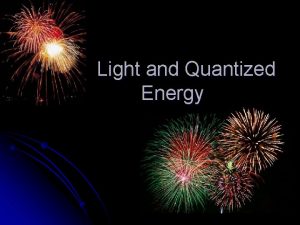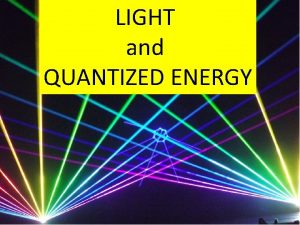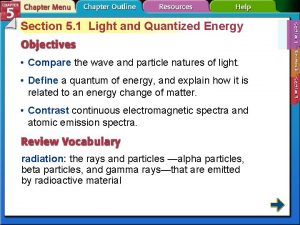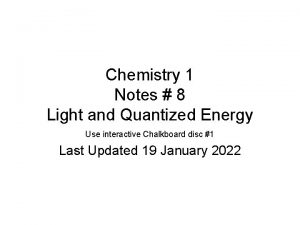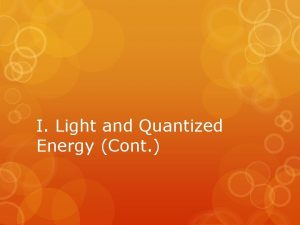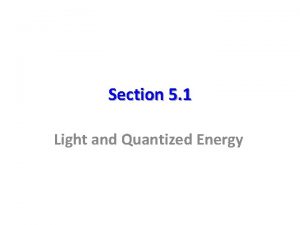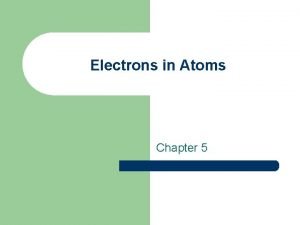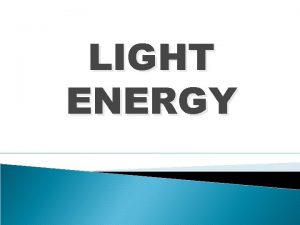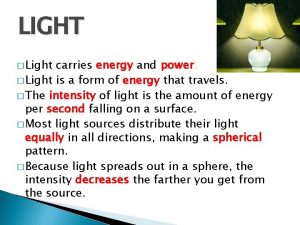Chapter 5 1 Light and Quantized Energy u






















































![Practice u Ba [Xe]6 s 2 u u Mg [Ne]3 s 2 u u Practice u Ba [Xe]6 s 2 u u Mg [Ne]3 s 2 u u](https://slidetodoc.com/presentation_image_h2/fad64c1e2862551e9c190a3bc9bb54cb/image-55.jpg)





- Slides: 60

Chapter 5. 1 Light and Quantized Energy u Wave-Particle Nature of Light • Electrons and light have a dual waveparticle nature. • Light which are particles behave as waves. • Electromagnetic Radiation (EMR) u Form of energy that exhibits wavelike behavior and travels at the speed of light. • Speed of Light (C) = 3 x 10 8 m/s (in a vacuum)

Components of a Wave u Wavelength ( ) lambda • Units: any unit of length (m) • Distance between corresponding points of a wave. • Crest to Crest or Trough to Trough


Components of a Wave u Frequency ( ) nu • Units: Hertz (Hz) or 1/s • How often a wavelength passes a given point in time.

Components of a Wave u Amplitude • Height of the wavelength. • Measured from the origin to crest or origin to trough. • Brightness of light.

Wavelength vs. Frequency u C= • • Inversely proportional. • As wavelength increases, frequency decreases.

u Spectrums • Range of wavelengths for a series of waves. u Electromagnetic Spectrum • Consist of all electromagnetic radiation. u Continuous Spectrum • Spectrum where all wavelengths within a given range are together. u Examples: Visible Light, X-Rays, U. V. Light, etc


u 7 Parts EMR Spectrum • Longest wavelength to Shortest: Radio u Microwaves u Infrared u Visible Light u U. V. Light u X-Rays u Gamma-Rays u

u Problems • What is the wavelength of EMR that has a frequency of 7. 50 x 10 12 Hz?

Problems: u 1. Determine the frequency of light with a wavelength of 4. 257 x 10 -7 cm. u 2. What is the wavelength of U. V light that has a frequency of 4. 50 x 10 16 Hz? u 3. What is the wavelength and color of light, that has a frequency of 6. 00 x 10 14 k. Hz? u

Answers: u 1) 7. 047 x 10 16 Hz u 2) 6. 67 x 10 -9 m u 3) 5. 00 x 10 -10 m u

Chapter 5. 2 Quantum Theory u Photoelectric Effect • Emission of electrons by certain metals when sufficient light shines on them. u Photoelectric effect

Chapter 5. 2 Quantum Theory u Photoelectric Effect

Chapter 5. 2 Quantum Theory u Photoelectric Effect

Chapter 5. 2 Quantum Theory u Quantum • Finite quantity of energy that can be gained or lost by an atom. • Planck’s Equation: E = h h u. E u u = = 6. 63 x 10 – 34 Js quantum of energy Photon • An individual quantum of light, caused by electrons losing quanta of energy.

Chapter 5. 2 Quantum Theory u Visible Light Emissions • As electrons gain quanta of energy they release it in the form of photons. • Energy States of an Atom Ground State- an atoms lowest energy level. u Excited State- an atoms highest energy level. u , is produced when electrons Line from Spectrum drop the excited to the ground states. u


Chapter 4. 2 Quantum Theory

Chapter 5. 2 Quantum Theory u Problems: • What is the energy of U. V. light with a frequency of 4. 50 x 10 16 Hz? u E = h , h = 6. 63 x 10 – 34 Js

Chapter 5. 2 Quantum Theory u Problems: • Determine the energy of light that has a wavelength of 450 nm.

Problems: u 1. What is the energy of a photon of green light with a frequency of 5. 80 x 1014 1/s? u 2. What is the energy, in joules, of a quantum of radiant energy whose wavelength is 6. 82 x 10 – 6 cm? u 3. Determine the wavelength of a photon that has 3. 11 x 10 – 19 J of energy. u 4. Determine the frequency, in MHz, of a photon that has wavelength of 1. 36 x 1010 nm. u

Summary u u u Planck – restricted the amount of energy that an object emits or absorbs as a quantum. (E = h ) Einstein – used Planck’s theory and explained the photoelectric effect. Compton – light travels as tiny particles, photons.


Bohr’s Model u u u The Line Spectra demonstrates that the energy levels of an electron in an atom are quantized Similar to the rungs of a ladder, nothing exist in between. (For Hydrogen (1 p+ & 1 e- ) • 1 st Energy Level • 2 nd & so on u u n=1 n = 2, 3, 4, 5, 6, … ∞ Only electrons dropping from a Higher Level to a Lower one emit EMR A Number of Possibilities for electron drops

Hydrogen’s Line Spectrum Several Series of lines are observed u Electron Drops to the n = 1 Level u • Lyman Series (U. V. Range) u Electron Drops to the n = 2 Level • Balmer Series (Visible Range) u Electron Drops to the n = 3 Level • Paschen Series (Infrared Range)

u u The Lines become more closely spaced as the levels increase The Bohr model explained spectral lines but not how atoms bonded. • Ultimately Displaced

1924 Louis de Brogile u French Graduate Student (asked an important question) • If light behaves as waves & particles, can particles of matter behave as waves? • Derived an Equation u Predicts that all matter exhibits h – Planck’s Con. wavelike motions. m – mass v - velocity

Dual Slit Dr. Quantum u Large Objects – Small Wavelengths • 200 g Baseball @ 30 m/s = 10 -32 cm • Undetectable u Small Objects – Large Wavelengths • 9. 11 x 10 -28 g @ 30 m/s = 10 -3 cm • Very Detectable w/ proper instruments u New Ballgame • Classical Mechanics vs. Quantum Mechanics

Uncertainty of Light Heisenberg’s Uncertainty Principle u It is impossible to know exactly both the position & the momentum of a particle at the same time. • Position then Momentum

Classical Vs Quantum 1. 2. Classical adequately describes the motions of bodies much larger than the atoms of which they are composed. It appears that such a body loses energy in any amount. Quantum describes the motions of subatomic particles and atoms as waves. These particles gain or lose energy in packages called quanta.

Quantum Mechanical Model u u u Max Born - Modern description of the electrons derived from the mathematical solution to the Schrodinger equation. Erwin Schrodinger - used wave mechanics to show the electrons about the nucleus emit vibration frequencies that were constant. Quantum Numbers - specify the properties of atomic orbital and their electrons. distance from the nucleus. Atomic Model Simulation Quantum Mechanics Video

Chapter 5. 2 Quantum Numbers u Principal Quantum Number (n) • Main energy level surrounding the nucleus. • Size of each orbital. • Primary distance from the nucleus. • Has values of n =1 to 7, 1 is the closest 7 is the farthest from the nucleus.

Quantum Numbers u Orbital Quantum Number (l) • Shape of the orbitals. • Referred to as subshells.

Quantum Numbers s orbital d orbital p orbital f orbital

Quantum Numbers u Magnetic Quantum Number (m) • Orientation of an orbital about the nucleus. • l = s u m=0 • l = p u m = -1, 0, 1 • l = d u m = -2, -1, 0, 1, 2 • l = f u m = -3, -2, -1, 0, 1, 2, 3

Quantum Numbers u s orbital, 1 orientation.

Quantum Numbers u p orbital, 3 orientations. px orbital pz orbital py orbital pxyz orbital

Chapter 4. 3 Quantum Numbers u d orbital, 5 orientations.

Quantum Numbers u f orbital, 7 orientations.

Quantum Numbers u Spin Quantum Number(+1/2 , -1/2) • Indicates two possible states on an electron in an orbital.

Quantum Numbers u Magnetism • Caused by the motion of electrons about the nuclei of atoms. • Diamagnetism – substance is weakly repelled by a magnetic force. • Paramagnetism – substance is weakly attracted by a magnetic force. • Ferromagnetism – Strong attraction by a magnetic force.

Quantum Numbers Atomic Orbitals Principal Energy Level N=1 Sublevels Orbitals 1 s 1 s N=2 2 s, 2 p N=3 3 s, 3 p, 3 d N=4 4 s, 4 p, 4 d, 4 f 2 s(one) + 2 p(three) 3 s(one) + 3 p(three) + 3 d (five) 4 s(one) + 4 p(three) + 4 d (five) + 4 f(seven)

Chapter 5. 2 Quantum Numbers Principal Q. N. 1 # Orbitals per # Electrons Main level per main level 2) 2 (2 n (n ) 1 2 2 4 8 3 9 18 4 16 32

Chapter 5. 2 Quantum Numbers Orbital Max # electrons s 2 p 6 d 10 f 14

5. 3 Rules Governing Electron Configurations Electron Configuration – arrangement of electrons in the atom Rules u Aufbau Rule – electron occupies the lowest energy level that will receive it. u Hund’s Rule – orbitals of equal energy each receive one electron (equal spin) before any receive two. u Pauli’s Exclusion Principle – no two electrons can have the same set of 4 quantum numbers (n, l, m, s)

Orbital Notation u Orbital Notation • Orbital represented by a line ____ or • Electron is represented by an ½ Arrow + ½ ( ) u - ½ ( ) u • Examples H (1 e-1) He (2 e-1)

Order of Energy Levels u u u 1 s 2 s 2 p 3 s 3 p 4 s 3 d 4 p 5 s 4 d 5 p 6 s 4 f 5 d 6 p 7 s 5 f 6 d Number - principal quantum number, the main energy level • Letter – orbital quantum number, the shape Useful Diagram 1 s Atomic Orbitals 2 s 3 s 4 s 5 s 6 s 7 s 2 p 3 p 4 p 5 p 6 p 7 p 3 d 4 d 5 d 6 d 7 d 4 f 5 f 6 f 7 f

Orbital Notation u Write the orbital notation for the following elements: • Al • Zn • P • Cl 1 s 2 s 3 s 4 s 5 s 6 s 7 s 2 p 3 p 4 p 5 p 6 p 7 p 3 d 4 d 5 d 6 d 7 d 4 f 5 f 6 f 7 f Atomic Orbitals

Electron-Configuration Notation Eliminates the lines & arrows u Superscripts are used to illustrate the number of electrons in the sublevel u Same order of sublevels u Examples u • H (1 e-1) - 1 s 1 • He (2 e-1) - 1 s 2 • Li (3 e-1) - 1 s 22 s 1

Electron-Configuration Notation u Write the short-hand electronconfiguration for the following: • Br • Pb • Cs • Kr 1 s 2 s 3 s 4 s 5 s 6 s 7 s 2 p 3 p 4 p 5 p 6 p 7 p 3 d 4 d 5 d 6 d 7 d 4 f 5 f 6 f 7 f

Noble Gas Configuration Shortest method of writing the electron configurations. u Use the last noble gas to occur prior to the element that is being configured. u Start at the n. S where n equals the period in which the element being configured can be found. u • Example: Zr u Noble gas would be Kr and start configuration at 5 s.

Writing in noble gas configuration u u Al Write the noble gas configuration for the following: • V • Rb • I • Hg • U • W

Exceptions to Aufbau All elements prefer a more stable configuration of electrons. u Fully filled and ½ filled orbitals are more stable than others. u Elements that are 1 shy of a full or ½ filled d orbital configuration will have electrons transfer from the s to the d to reach this stable state. u Example if you have a 4 s 2 and 3 d 4 the actual configuration should be 4 s 1 and 3 d 5. u
![Practice u Ba Xe6 s 2 u u Mg Ne3 s 2 u u Practice u Ba [Xe]6 s 2 u u Mg [Ne]3 s 2 u u](https://slidetodoc.com/presentation_image_h2/fad64c1e2862551e9c190a3bc9bb54cb/image-55.jpg)
Practice u Ba [Xe]6 s 2 u u Mg [Ne]3 s 2 u u W [Xe]6 s 14 f 145 d 5 u u Ag [Kr]5 s 14 d 10 u u Sb [Kr]5 s 24 d 105 p 3 u

Identifying Electrons u u Paired electrons – when 2 electrons are within the same orbital. Unpaired electrons – when a single electron is within an orbital.

Identifying Electrons u How many unpaired electrons does the following elements have? • Na • O • B

Electron Dot Notation Describes the number of electrons in an atom’s outer electron cloud, or highest energy level, as dots around the symbol. u Valence electron - refers to the highest energy level electron within an atom. u

Electron Dot Notation Draw the electron-configuration and electron-dot notation for Nitrogen. u 1 s 2 2 p 3 u The highest energy level is 2. u There are 5 valence electrons in Nitrogen. u

Electron Dot Notation u Write the noble gas-configuration and electron dot notation for the following. • Al • As • I • Sr
 Electrons in atoms section 1 light and quantized energy
Electrons in atoms section 1 light and quantized energy Electrons in atoms section 1 light and quantized energy
Electrons in atoms section 1 light and quantized energy Section 1 light and quantized energy
Section 1 light and quantized energy Section 1 light and quantized energy
Section 1 light and quantized energy Light light light chapter 23
Light light light chapter 23 Light light light chapter 22
Light light light chapter 22 Light light light chapter 22
Light light light chapter 22 Quantized inertia
Quantized inertia ________ converts light energy into chemical energy. *
________ converts light energy into chemical energy. * Photosynthesis transforms light energy into chemical energy
Photosynthesis transforms light energy into chemical energy Energy energy transfer and general energy analysis
Energy energy transfer and general energy analysis Energy energy transfer and general energy analysis
Energy energy transfer and general energy analysis Put out the light
Put out the light Membrane bound organelles
Membrane bound organelles The bouncing off of light.
The bouncing off of light. Chapter 7 energy conservation of energy
Chapter 7 energy conservation of energy Material that blocks light
Material that blocks light Solar energy is radiant light and heat from the sun
Solar energy is radiant light and heat from the sun Heat light and sound energy
Heat light and sound energy What us energy
What us energy Energy transformation of light bulb
Energy transformation of light bulb Forms of energy
Forms of energy Radiant vs light energy
Radiant vs light energy What form of energy that travels in a straight line
What form of energy that travels in a straight line Example of light energy
Example of light energy Light bulb sankey diagram
Light bulb sankey diagram Light energy bill nye
Light energy bill nye Efficiency igcse physics
Efficiency igcse physics Energy is the ability to do
Energy is the ability to do Light energy
Light energy Different wavelengths
Different wavelengths Non-cyclic photophosphorylation
Non-cyclic photophosphorylation Plants gather energy with light-absorbing pigments called *
Plants gather energy with light-absorbing pigments called * Do light waves transfer energy
Do light waves transfer energy Light graphic organizer
Light graphic organizer Energy of light wave
Energy of light wave Chemical potential energy images
Chemical potential energy images Primary energy and secondary energy
Primary energy and secondary energy What is commercial energy source
What is commercial energy source Helmholtz free energy
Helmholtz free energy Renewable energy and energy efficiency partnership
Renewable energy and energy efficiency partnership Elastic potential energy examples
Elastic potential energy examples Conservation of mechanical energy
Conservation of mechanical energy Kinetic energy and potential energy formula
Kinetic energy and potential energy formula Potential energy units
Potential energy units Eroei
Eroei Chapter 18 the electromagnetic spectrum and light
Chapter 18 the electromagnetic spectrum and light How are shadow formed
How are shadow formed Section 4 review physical science
Section 4 review physical science Spring kinetic energy formula
Spring kinetic energy formula Gibbs free energy unit
Gibbs free energy unit Gibbs free energy
Gibbs free energy Ep potential energy
Ep potential energy Thermal energy vs heat energy
Thermal energy vs heat energy A hairdryer converts ____ energy into ____ energy.
A hairdryer converts ____ energy into ____ energy. Electric potential energy formula
Electric potential energy formula How to convert mechanical energy to electrical energy
How to convert mechanical energy to electrical energy Thermal energy section 3 using thermal energy
Thermal energy section 3 using thermal energy Gibbs energy and equilibrium
Gibbs energy and equilibrium What ecological role best describes grizzly bears?
What ecological role best describes grizzly bears? As a roller coaster goes downhill
As a roller coaster goes downhill
